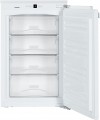Power failure autonomy
The amount of time the freezer keeps food cold enough when the refrigeration system is turned off, for example, due to a breakdown or power outage. Technically, the power failure autonomy for each model is calculated differently; For example, for a freezer with an operating temperature of -18 ° C, this is the period during which the products in the chamber heat up from -18 ° C to -9 ° C. To sum up, the time is indicated during which the frozen products are guaranteed not to heat up to a temperature at which they could lose their properties.
Freeze capacity
One of the main indicators of freezer performance is the approximate amount of fresh food that the freezer can completely freeze from room temperature to the minimum operating temperature in 24 hours. For domestic use, a power of 10-15 kg/day is considered quite sufficient. More performant models may be required if you have to freeze a lot of food at a time or for industrial purposes.
Child lock
The child lock allows you to block freezer controls and/or access to its internal volumes. This function will be useful in families where there are small children. Thus, the child will not be able to get to the freezer controls and change its operation mode.
Noise level
The average noise level generated by the freezer during operation. The quietest models give out about 25 - 30 dB — this is the average noise background in a residential area at night (comparable to the ticking of a wall clock); the loudest — is about 60 dB (loud conversation). More detailed comparison tables can be found in special sources.
In any case, the lower the noise level, the more comfortable the use of the unit. However, it does not always make sense to look for the
quietest freezer: in some situations (for example, in a noisy workshop), the freezer's sound may be lost against the surrounding noise background. In addition, reduced noise often affects the price.
Door panel hinge
—
Sliding hinget. A sliding hinge involves the connection of a decorative panel with a freezer door using movable guides. So, with the sliding hinge, the front decorative facade is equipped with its hinges, and the freezer door is practically not loaded by the panel. On the other hand, with this type of hinge, there is a small gap between the decorative panel and the freezer door, in which dust can accumulate. Additionally, the sliding hinge does not allow the freezer door to be opened more than 90-95˚.
—
Fixed hinge. With a fixed hinge, the panel is hung on the freezer door. It is the easiest and fastest option for installing the decorative panel. The fixed hinge assumes that the decorative panel loads the door hinges of the freezer. When choosing the fixed hinge for the panel, it should be taken into account that if the door of the freezer is not sufficiently reliable, the door of the built-in unit may be overloaded. Most often, the fixed hinge of the panel is used when installing a relatively small freezer. The compact panel is unlikely to overload the freezer door.

